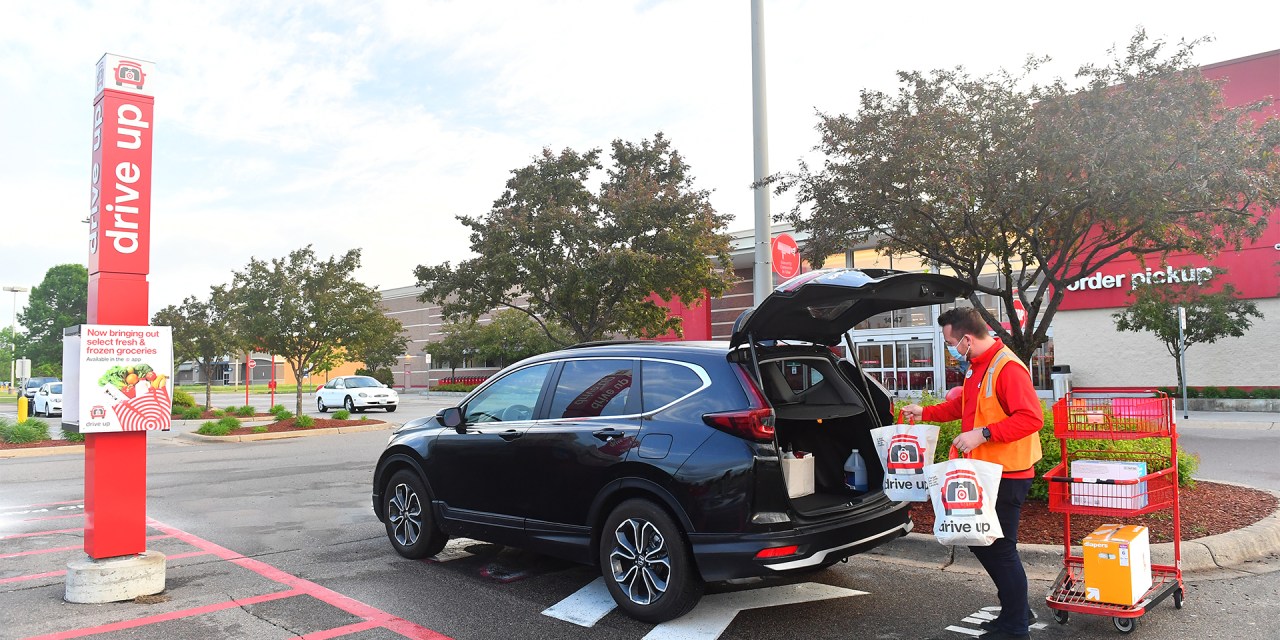Target announces plans to invest $5B mainly in stores as same-day services drive growth

Target has grown sales every quarter of the pandemic — as well as the 11 quarters before that — by keeping brick-and-mortar stores relevant through digital integrations.
On Tuesday, Target reported full-year 2021 revenue growth of 12.7% to a total $106 billion, as well as double-digit year-over-year growth in each of its five core merchandise categories. According to executives, this sales growth was largely driven by Target’s same-day fulfillment services; 95% of its total sales were fulfilled via its stores. As a result, the company announced plans to invest a further $5 billion mainly in its brick-and-mortar stores and fulfillment. In turn, in 2022, Target will open 30 new stores and remodel 200 preexisting stores
At a time when many brands and retailers are still struggling to figure out the role of stores amid fluctuating foot traffic trends, Target has made the physical store central to its growth strategy. Fulfillment in-store, curbside pickup, buy online, pickup in-store (BOPIS) and brick-and-mortar foot traffic all grew year-over-year and on a two-year stack after continued investment in the services.
Digital orders, physical pick up
While many retailers added buy online, pickup in-store (BOPIS) and curbside pickup for the first time during the pandemic, Target has embraced curbside orders via its Drive Up program since 2018. Target has focused on expanding curbside and BOPIS over the past two years and, indeed, grew same day fulfillment revenue 400% since 2019.
“[Same day services] are the fastest-growing part of our business… showing the continued guest appetite for fast and easy shopping,” said COO John Mulligan at the retailer’s earnings call today.
Same-day sales — including curbside, BOPIS and last-mile delivery platform Shipt — were up 45% year-over-year in 2021, on top of 235% growth in 2020. Curbside in particular, was up 70%. To drive these sales, Target has invested significant amounts of time, money and floor space into its many same-day offerings over the past two years.
Late last year, Target announced that it was adding an additional 18,000 more assigned curbside spaces in its store to accommodate pickup and adding new curbside app features like an option for another family member or friend to pick up an order under a different name. Last week, Target announced it was piloting curbside returns as well as curbside Starbucks pickup from its Starbucks store-within-stores.
“They have removed a lot of the barriers that are associated with same-day pickup,” said Tiffany Hogan, a director of retail insights at Kantar. “They don’t require minimums in your order, there’s no fees, there’s no time slots… as they love to say, they leaned into it earlier than a lot of their competitors and I think that’s why it’s paying off for them.”
Chief stores officer Mark Schindele also explained at the presentation this morning that employees are now also being trained to work across the different models, rather than being siloed to just curbside fulfillment or just in-store work for more flexibility.
In turn, foot traffic analytics firm Placer.ai found that Target was greatly outpacing Walmart in two-year foot traffic growth, up double digits in months where Walmart was down in visits year-over-year.
“[Target’s] focus on being strong through all channels while understanding how to use these channels together to provide a holistic experience is a key element of Target’s ongoing success,” Placer.ai’s VP of Marketing Ethan Chernofsky said.
Optimizing in-store fulfillment
At the same time as Target has adapted its consumer-facing same-day offerings, the retailer has also been bolstering stores’ capacities to serve as fulfillment hubs.
This year, more than 95% of Target’s total sales — both physical and digital — were fulfilled by stores. Compared to traditional “upstream shipping,” same day pickup provides 90% in savings while ship local saves the retailer 40%, according to Schindele.
However, the rapid influx of these new and varied omnichannel orders has forced the retailer to rethink store concepts to better accommodate fulfillment.
In the past, explained Schindele, in-store teams would “palletize” same-day packages in the “backroom” of Target stores for pickup from a variety of partners. Now, Target is building out new store concepts and facilities with same-day fulfillment in mind.
Target’s 30 new store and 200 remodels will help the Target team meet demand via “enhanced hold space and pickup areas for online fulfillment,” according to the company. Alongside these changes, moreover, Target promised to “complete hundreds of smaller projects across the chain to support the growth of its fulfillment services.”
And — where fulfillment needs are outgrowing the store altogether — Target is creating new facilities to segment “in-store fulfillment” out of store. Last year, Target piloted a “sortation center” in Minneapolis that organizes the orders that are packed by local stores and gets them ready for delivery. This spring, Target will open five additional centers in Dallas, Houston, Austin, Atlanta and Philadelphia.
“Sortation centers will make stores even more efficient as fulfillment hubs and allow us to roll out a next day delivery capability at scale,” said Schindele. “This capability isn’t something we built overnight. It’s the result of many strategic decisions we’ve made over time working together in a model that’s unique to Target.”
